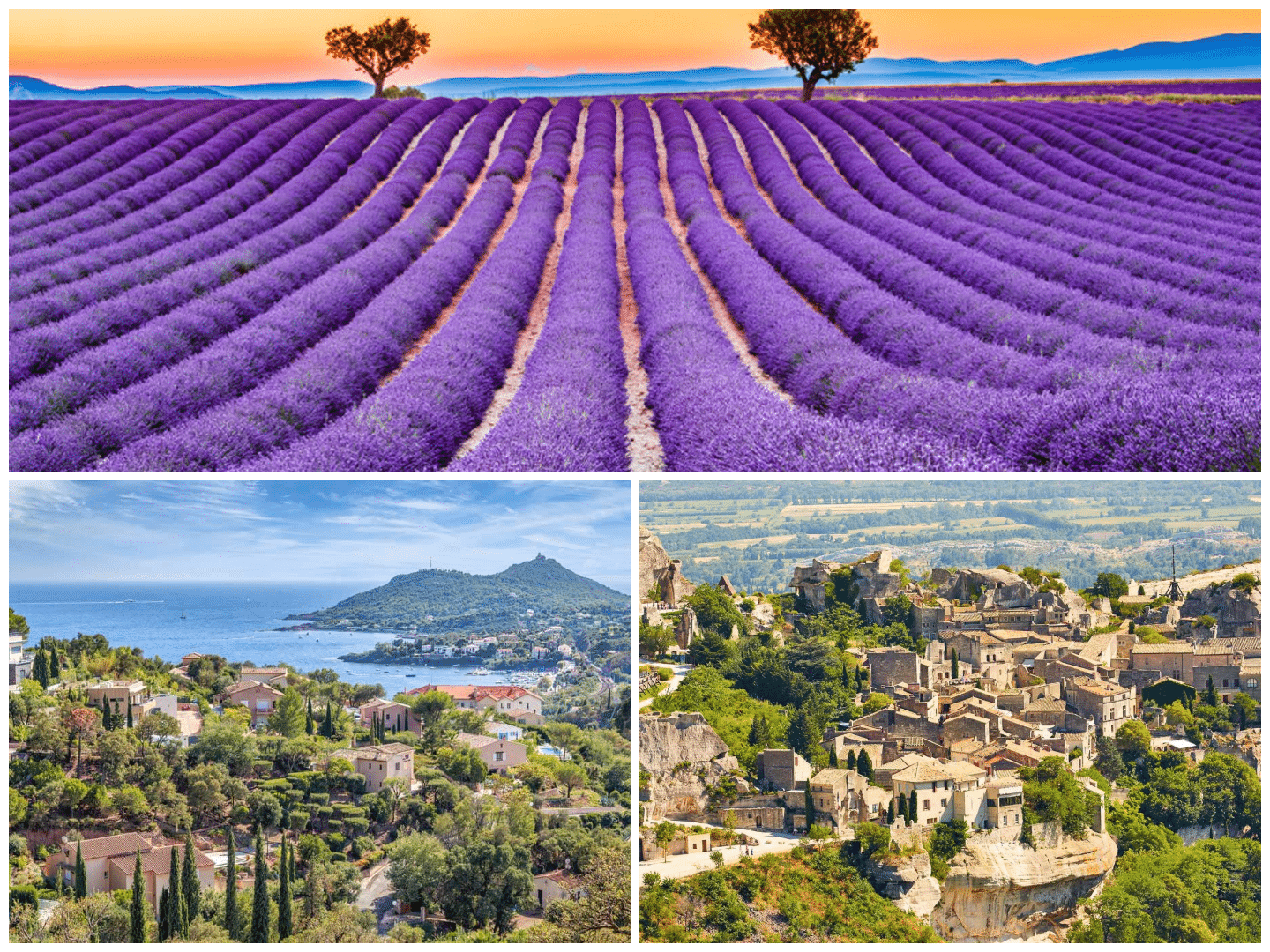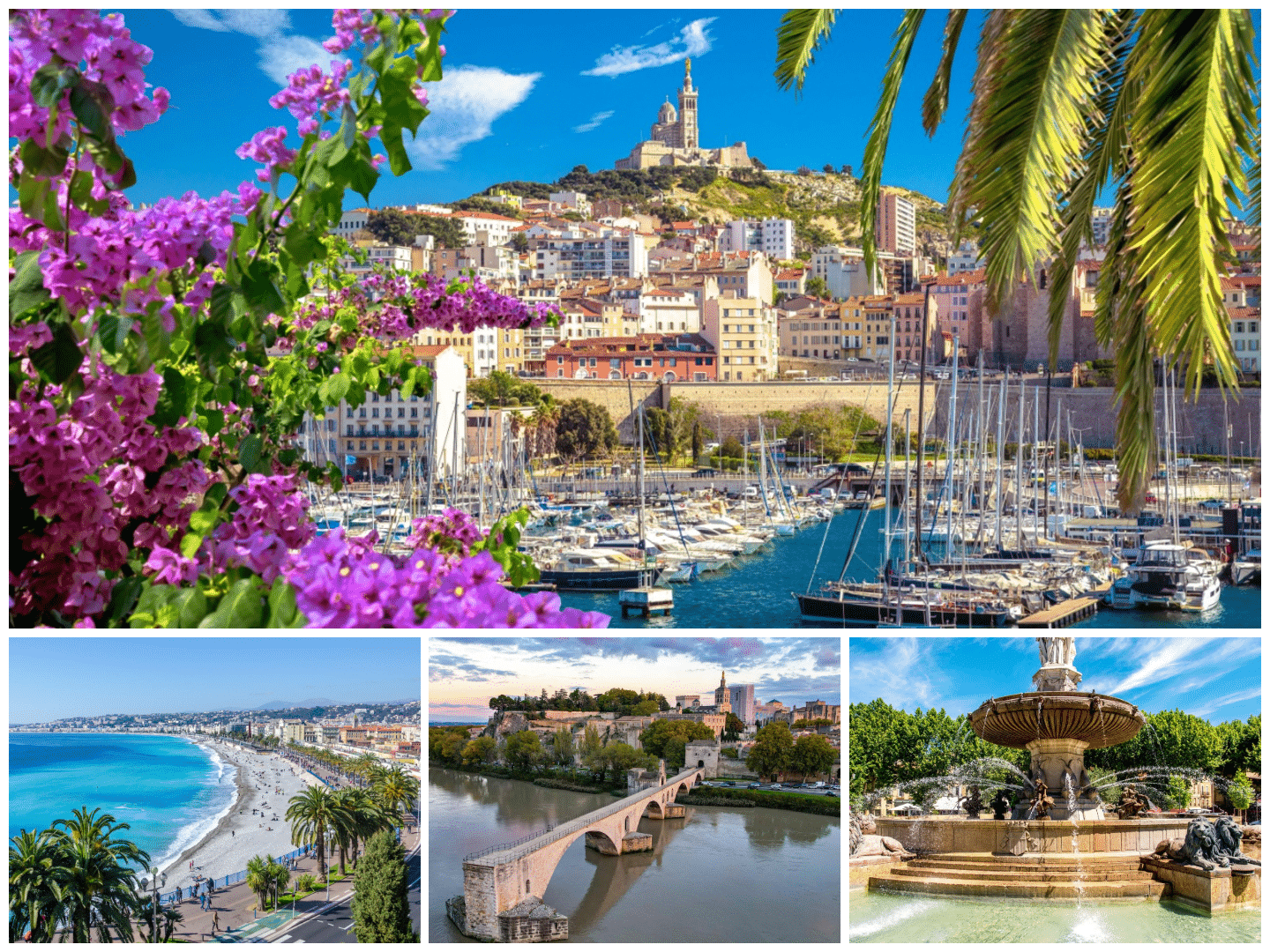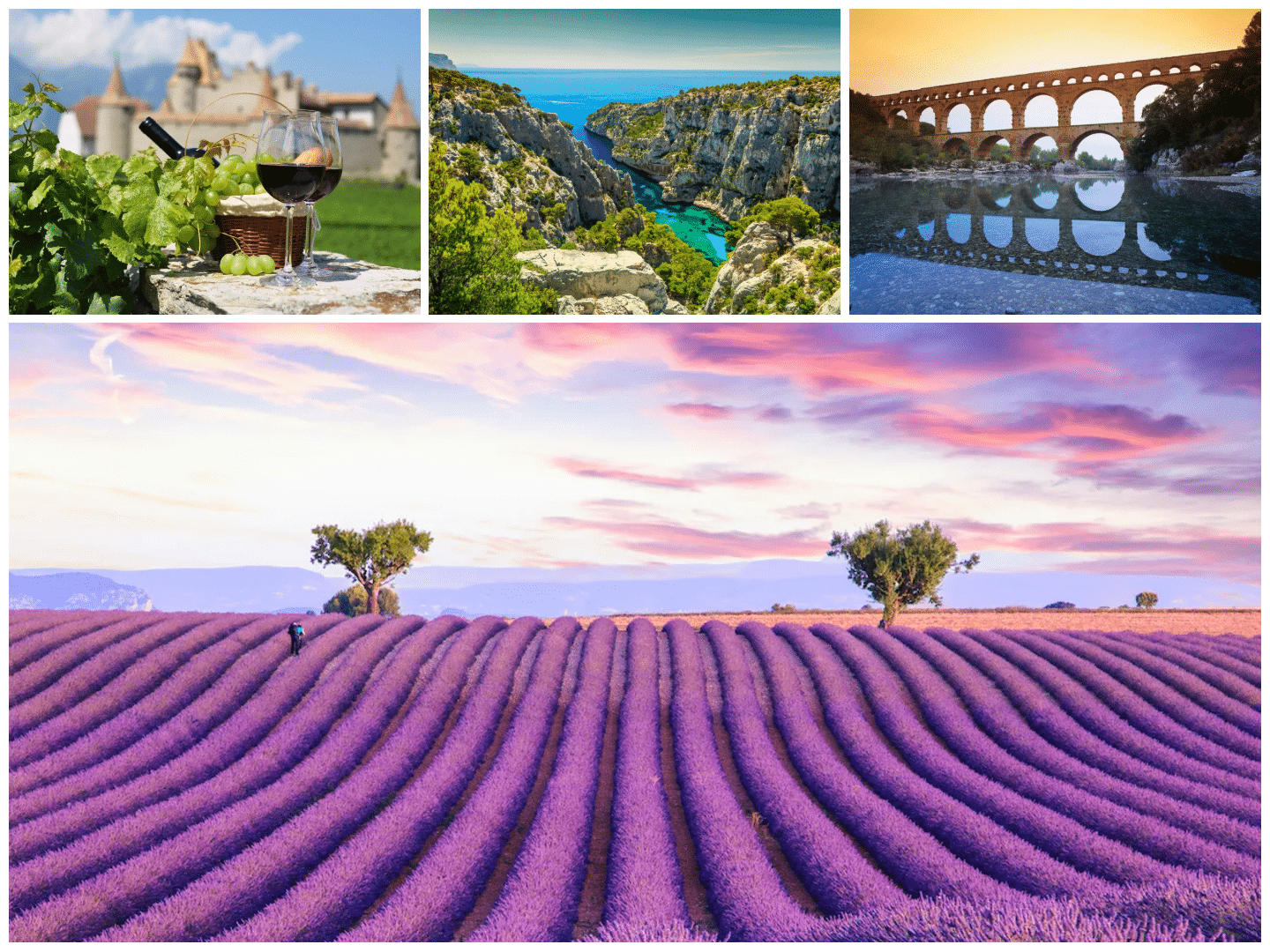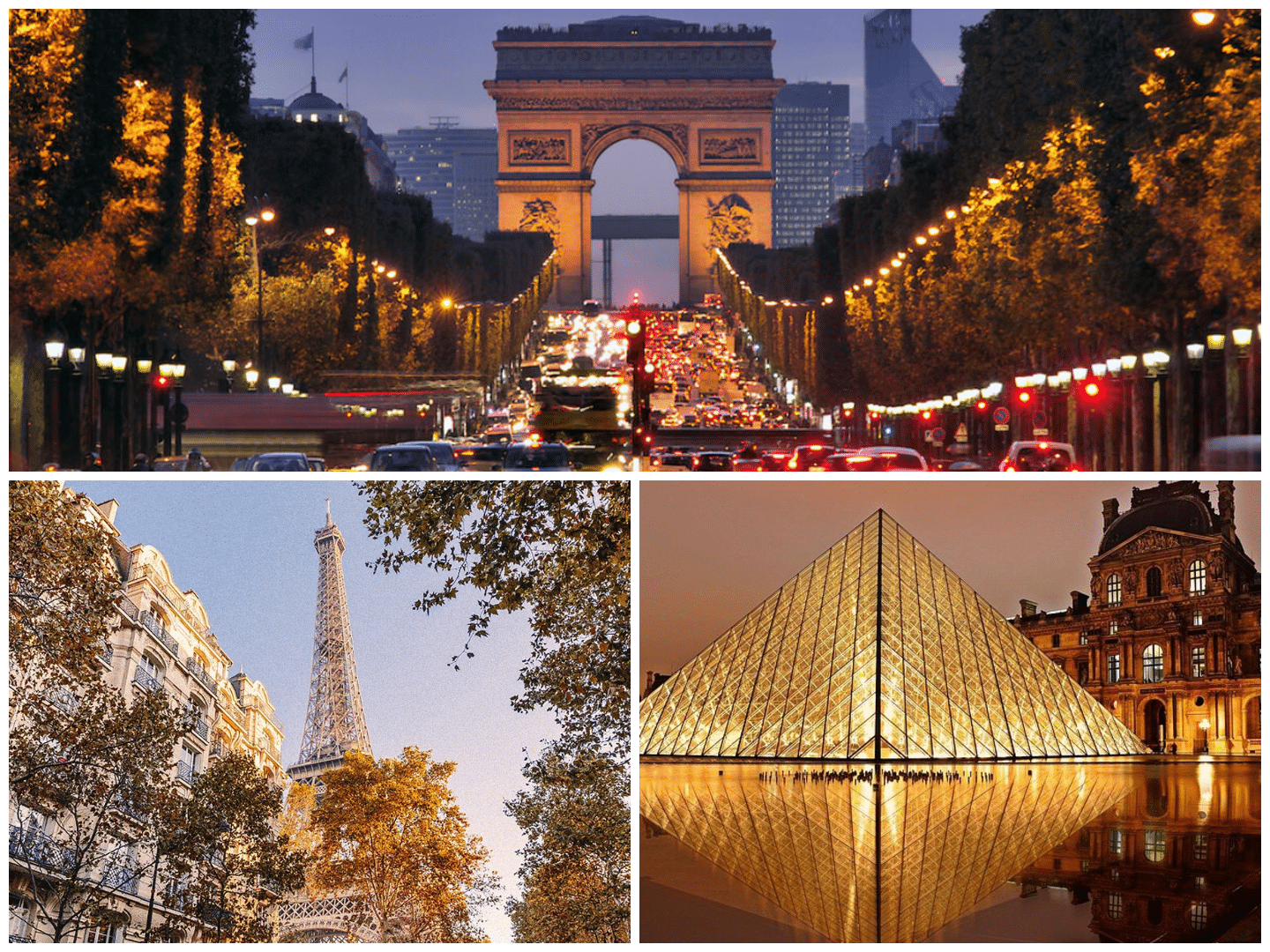Have you chosen Provence (France) as your next holiday destination? Here’s some information to help you decide how to get there and which means of transport will be most suitable. Provence, located in the southeastern region of France, is renowned for its stunning landscapes, charming villages, and rich history. When planning your trip to Provence, here are some tips on how to structure your trip and what to do:

© Shutterstock
Our website includes affiliate links. So, remember that we may receive commissions when you click our links and make purchases. Please read our legal disclaimer document for more information about our Affiliate disclaimer and other disclaimers like the Fair-Use disclaimer.
How to Plan Your Trip to Provence
Some basics
Plan your trip to Provence a few months in advance, especially during peak season. This gives you enough time to book flights, accommodations, and activities.
Since Provence is big, focus on one or two areas to help create your itinerary based on what you want to see and do. You will need a car to get around. Different parts of Provence attract visitors at other times of the year. The Riviera is great for sunbathing in summer, while ski resorts welcome visitors in winter. August is the busiest month, so early fall and late spring are better for good weather, fewer crowds, and lower prices.
Remember to notify your bank and credit card company about your travel plans. If you want more structure during your visit, consider booking a guide or tour. Also, consider travel insurance for any unexpected situations.
How to get to Provence
The best way to get to Provence depends on your travel preferences. Flying is fast and often cheap, while having a rental car makes it easier to get around once you arrive. Consider the Auto Train, which lets you start your vacation relaxed and explore the countryside in your car. This option is great if you are traveling from Paris or the UK. If you don’t take guided tours, public transport may be limited to get to attractions.
Depending on where you want to go in Provence, you can fly directly into Marseille, Nice, Avignon, Montpellier, Nimes, or Lyon. This information is helpful for travelers from the UK, the US, and other parts of Europe.
Another good option is to travel by train. The TGV train offers a quick and comfortable ride through France’s beautiful scenery. It connects cities like Paris and London to places in Provence, including Avignon and Marseille. The TGV features modern amenities and has plenty of luggage space.
Book TGV tickets in advance to get the best prices and secure your seat. You can buy tickets online on the SNCF website or through travel agencies like Omio or Trainline.
How to get around Provence
When visiting Provence, you have two main choices: public transportation or driving a car. We recommend renting a car for a fun road trip. This lets you visit villages and enjoy beautiful landscapes at your own pace. You can easily stop at lavender fields and charming towns along the way.
If you prefer a slower pace, local TER trains are a great option to see the countryside. These trains connect smaller towns, allowing you to hop on and off to explore local attractions. You can buy tickets at the train station or online.
While some towns have public transportation, having a car is essential for reaching hidden gems, vineyards, and local markets. Many places have limited transport options. Major car rental companies are located at airports and train stations. Booking your car in advance is a wise move, especially during high season. Consider renting a hybrid or electric vehicle, as charging stations are now available in Provence.
In summer, towns can become crowded. Look for parking lots on the outskirts; larger cities may have “park and ride” options. Pay attention to parking signs. Avoid areas marked “interdit sauf riverain” (residents-only parking), and make sure to pay if you see a “payant” sign. Always show your payment receipt unless the parking system uses number plate detection. We hope this guide helps you travel easily around Provence.
Plan your route
When planning your trip, think about practicality. Unlike the French Riviera, where buses and trains connect the entire coastline and run regularly to popular places, Provence is more rural.
You can reach some cities by train, like Arles, Aix-en-Provence, and Avignon. However, getting to remote areas like Verdon Gorge or Camargue will be trickier without a car. Many iconic villages lack train connections, and relying on buses can waste your limited time.
Visit the Rome2Rio website to plan your trip easily. This site helps you find different travel options. You can compare routes based on what is most important to you, like the cheapest, fastest, or most eco-friendly travel methods. Rome2R provides detailed information on various travel methods, including flights, trains, buses, ferries, and car rentals.
Decide on the duration of your trip to Provence.
A week is an ideal duration for exploring the highlights of Provence, although more extended stays allow for a deeper exploration. We recommend staying a couple of weeks to make the most of your stay in Provence, France. Seriously, from incredible landscapes of vineyards, flower fields, and olive trees to charming cities and villages like Avignon, and glamorous spots on the French Riviera, you’ll regret rushing your stay in southeastern France.

Some of the more popular places to stay in are Marseilles (top), Nice (left down), Avignon, or Aix-en-Provence (right down).
© Shutterstock
Where to stay on your trip to Provence?
When choosing your base, always consider your personal preferences. Are you traveling with family or solo? Do you like cultural sights or nature? Do you want to explore the inland or prefer to stay on the beach? These are just some of the most essential questions you should ask yourself before planning your trip to Provence.
The Luberon Valley is a beautiful place to experience Provençal life. You can explore charming villages like Roussillon, which has bright ochre colors, and Gordes, which is known for its château.
If you love lavender, visit the Abbaye Notre-Dame de Sénanque in summer, when the fields bloom. The Plateau de Valensole also has stunning lavender views. Don’t forget to visit the lavender museum to learn about its significance in Provençal culture.
Cassis is a lovely port town, perfect for beach lovers, and an excellent spot for a relaxing holiday. It is also where the Calanques de Cassis begin, featuring hidden coves and beautiful coastlines.
Marseille is a lively city that mixes modern and traditional elements. The Vieux-Port has been updated, while the nearby streets offer character and charm. Visit the Basilique Notre-Dame-de-la-Garde for amazing views of the city. Marseille is an excellent base for exploring the Mediterranean coast.
Arles and Nimes are towns brimming with history and culture. They are famous for their Roman monuments, including the impressive amphitheaters, and are a treat for history lovers. Stroll through the town’s streets, and you’ll find charming squares, lively markets, and cafés where you can relax and watch the world go by.
When to visit Provence
When to plan a trip to Provence should be a crucial question. Spring (April to early June) and Fall (September to October) are ideal for pleasant weather, fewer tourists, and beautiful scenery. Summer can be hot and crowded, but it is full of festivals. When is the best time to visit Provence?
Provence is a great place to visit from mid-June to mid-July when lavender fields bloom. July has hot, sunny weather and many tourists, but it’s the best time to see the flowers. For fewer crowds, visit in spring (April to early June) or fall (September to October) when the weather is nice.
Plan your trip between June and August to see the colorful lavender and sunflowers. Renting a car makes it easy to visit different towns and farms that allow visitors. Each season offers something special, such as vibrant lavender in late June or grape harvesting in the autumn. Booking accommodations early is essential during busy tourist months. Remember to stay on public paths when exploring the fields and respect private property.
Plan for Rest Days
Rest days don’t have to mean staying in your hotel room. You can engage in gentle activities that help your body recover while enjoying your vacation. Consider visiting a local café, taking a slow walking tour, or relaxing at the beach as great options for your rest day.
Holidays are an excellent time to try new foods. Take the opportunity to enjoy local cuisines at a relaxed pace. Eating out can also provide cultural insight, making each meal an adventure.
Many places offer wellness activities, including thermal baths, massages, and yoga classes. These options can enhance your rest day, promote relaxation, and make your holiday experience even more enriching.
Be flexible on timing.
In southern France, things can sometimes take a long time to happen. This can be enjoyable, like when you’re planning to have a leisurely Sunday lunch at your favorite restaurant. However, while sightseeing, you prefer a quicker lunch to move on to your next destination. It’s essential to remember that being rushed is not common here, so keep this in mind when planning your day.
Practice your French.
Speaking some of the local language is always lovely, and people in France appreciate it. It makes your experience more enjoyable when you can talk with the locals you meet. Most staff in hotels, restaurants, and tourist attractions speak basic English but don’t hesitate to try your French, no matter how skilled you are.

In Provence, you can admire historic towns and villages, swim in the beautiful sea, go for a hike and wine tasting, and, lastly, see the lavender fields. © Shutterstock.
What to Do on Your Trip to Provence
Firstly, you can explore historic towns. For example, visit Avignon to see the Palais des Papes and the famous bridge. You can also wander through the streets of Aix-en-Provence, known for its fountains and markets, or discover the ancient Roman ruins in Arles, including the amphitheater.
Secondly, enjoy nature. For instance, hike in Calanques National Park for stunning coastal views or explore the Luberon Valley, which features picturesque villages like Gordes and Roussillon. But if you’re visiting in late June to early August, don’t miss the lavender fields around Sault and Valensole.
The next option is wine tasting. Explore the vineyards of Châteauneuf-du-Pape or Bandol, or join wine tours or tastings to sample local wines.
Don’t forget the market days. Experience local life by visiting markets in towns like Apt, L’Isle-sur-la-Sorgue, and Saint-Rémy-de-Provence. Enjoy fresh produce, lavender products, and regional specialties.
Additionally, indulge in local culinary delights. Savor dishes like ratatouille, bouillabaisse, and various herbs de Provence. Be sure to try local pastries and olive oils.
Lastly, immerse yourself in cultural experiences. Attend festivals like the Avignon Theatre Festival in July or the various harvest festivals in the autumn. Visit art sites related to Van Gogh in Arles, where you can see the landscapes that inspired his paintings. Look for traditional Provençal events, such as bullfighting (distinct from Spanish bullfighting) or celebrations of Santon, which are the conventional clay figurines.
Trip to Provence: Travel Tips to Avoid Crowds and Overrated Stops
Some Provence destinations can feel overrated due to crowds, such as Gordes at midday, the main lavender route, and Palais des Papes in Avignon. So, visit these spots early or late, explore lesser-known areas, or choose alternative wine appellations. Not every popular spot in Provence is worth visiting. Here’s how to enhance your trip:
– Gordes: This beautiful village gets overcrowded by noon. Visit early in the morning or at sunset, or choose a quieter village nearby.
-Lavender fields: In July, the main lavender route is congested with traffic. Visit at off-peak times or explore less crowded areas.
– Vineyards: Châteauneuf-du-Pape is famous, but it is often rushed and commercial. Opt for lesser-known regions like Vacqueyras or Gigondas for a more intimate tasting experience.
Take a look at

The Best Things to Do in Paris
There are plenty of things to see and do in Paris—so many that you most likely won’t be able to

Top things to do in Marseille
In this Marseille guide, “The Top Things to Do in Marseille,” we highlight the must-see attractions and activities in this

Portofino – Italy’s paradise by the sea
This article, “Portofino-Italy’s Paradise by the Sea,” will demonstrate what draws people to this tiny town. Furthermore, we will also
